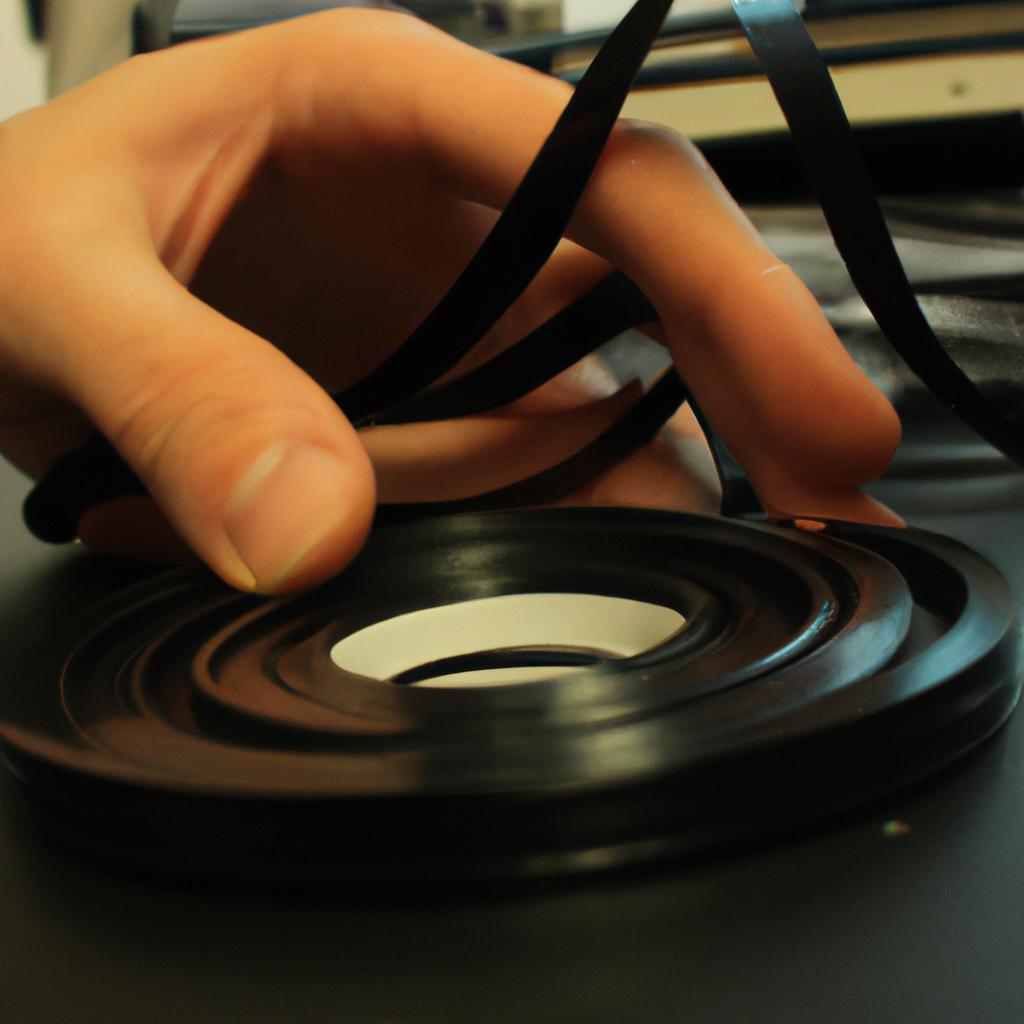Granular synthesis is a versatile technique employed in the creation of local noise music. This article aims to explore and analyze various techniques utilized in granular synthesis for the production of compelling and immersive soundscapes. By breaking down audio samples into tiny, discrete fragments known as grains, granular synthesis allows composers and performers to manipulate these elements individually, resulting in intricate and personalized sonic textures. To better understand the potential applications of this technique, consider a hypothetical scenario where an artist wishes to create a composition that reflects urban chaos. Using granular synthesis, they can extract snippets of city sounds such as car horns, sirens, and footsteps, rearranging them into dense layers of dissonance or rhythmic patterns that evoke a sense of bustling metropolitan energy.
The first section will delve into the fundamental principles behind granular synthesis. Exploring concepts such as grain size, density, duration, and pitch modulation will provide insights into how composers craft unique timbral landscapes through meticulous manipulation of individual grains within an audio sample. Additionally, this section will examine different methods for generating grains from existing sounds or creating custom-designed ones using specialized software tools.
Subsequently, the article will discuss various techniques used to control and shape these granules effectively. Analysis will include strategies like time-st retching, which alters the duration of the grains to create time-stretched effects. This technique can be used to elongate or compress specific sounds within a composition, allowing for subtle or dramatic transformations of the original audio material.
Another technique that will be explored is granular spatialization. By manipulating parameters such as grain position and movement within a virtual space, composers can create immersive soundscapes that transport listeners into different sonic environments. This section will discuss techniques like panning, diffusion, and multi-channel playback systems to achieve spatialization effects in granular synthesis.
Furthermore, the article will delve into advanced modulation techniques employed in granular synthesis. Modulation allows composers to add dynamic variations to the granules’ properties over time, enhancing expressiveness and creating evolving textures. Topics such as amplitude modulation, frequency modulation, and spectral modulation will be discussed in detail, along with practical examples of how these techniques can be applied effectively.
To provide a comprehensive understanding of granular synthesis in local noise music production, the article will also cover real-world case studies showcasing successful applications of this technique. These case studies may include interviews with artists who have embraced granular synthesis as a central element in their compositional practices and performances.
In conclusion, this article aims to demonstrate the versatility and potential of granular synthesis in creating compelling and immersive soundscapes for local noise music. Through an exploration of fundamental principles, manipulation techniques, modulation strategies, and real-world examples, readers will gain insights into how they can incorporate this powerful technique into their own creative endeavors.
Granular Synthesis: An Overview
Granular synthesis is a powerful technique in the field of music production that allows for the manipulation and transformation of audio samples at a microscopic level. By breaking down sound into small, discrete fragments known as grains, granular synthesis offers musicians and producers an array of possibilities to create unique sonic textures and effects.
For instance, imagine taking a recording of rainfall and using granular synthesis to isolate individual raindrops. Each droplet becomes a grain that can be manipulated in terms of pitch, duration, density, and spatial positioning within the stereo field. With such control over each element, composers can create immersive auditory experiences that evoke emotions ranging from tranquility to unease.
To better understand the potential impact of granular synthesis on music composition and production, consider the following bullet points:
- Exploration: Granular synthesis enables artists to push boundaries by exploring new timbres and experimental soundscapes.
- Expressiveness: The ability to manipulate individual grains provides a heightened sense of expressiveness in shaping musical narratives or conveying specific moods.
- Ambiguity: The use of granular techniques introduces ambiguity between familiar sounds and abstract textures, challenging listeners’ preconceptions about what constitutes “music.”
- Immersive Soundscapes: Through careful arrangement and manipulation of grains, composers can craft richly detailed sonic environments that transport listeners to otherworldly realms.
In addition to these creative opportunities, it is important to note some technical aspects associated with granular synthesis. The following table illustrates key parameters commonly used when working with granular synthesis:
| Parameter | Description |
|---|---|
| Grain Size | Determines the duration of each individual grain |
| Density | Controls the number of overlapping grains |
| Pitch Variation | Alters the pitch characteristics within each grain |
| Spatialization | Adjusts the position of grains within the stereo field |
By understanding these parameters, artists can effectively harness the potential of granular synthesis to create innovative and captivating musical compositions. In the subsequent section, we will delve deeper into the concept of noise in music and its relationship with granular synthesis techniques.
Transitioning from granular synthesis exploration, let us now explore the role of noise within this context.
Understanding Noise in Music
From the previous section discussing an overview of granular synthesis, we now delve deeper into the understanding of noise in music. To illustrate this concept, let us consider a hypothetical case study: Imagine a composer who seeks to create an immersive auditory experience by incorporating elements of local noise into their composition. By employing granular synthesis techniques, they aim to manipulate sound at a microscopic level, breaking it down into tiny sonic particles and reassembling them in new and unconventional ways.
To comprehend the significance of noise in music, several key factors should be considered:
- Expressive Potential: Noise possesses an inherent expressive potential that transcends conventional musical structures. It allows musicians to explore unconventional timbres and textures while challenging listeners’ preconceived notions of what constitutes music.
- Emotional Impact: The deliberate inclusion of noise can evoke a range of emotional responses in listeners. Dissonant or abrasive sounds may elicit feelings of tension or unease, whereas softer ambient noises might create a sense of tranquility or introspection.
- Spatialization Techniques: Granular synthesis offers composers the ability to spatialize sound sources within a virtual environment effectively. This technique enables the placement of individual grains across different positions within the stereo field, enhancing the perception of depth and immersion.
- Organic Soundscapes: By manipulating granules with various parameters such as duration, pitch, and density, composers can generate intricate and organic soundscapes that mimic natural phenomena or abstract sonic landscapes.
Consider the following table illustrating how different characteristics of noise can provoke emotional responses:
| Characteristic | Emotional Response |
|---|---|
| Abrasive | Tension |
| Soft | Tranquility |
| Chaotic | Unsettling |
| Harmonic | Serenity |
Moving forward from our exploration of noise in music, we will now shift our focus towards exploring granular synthesis itself – its techniques, methodologies, and creative applications. By delving into the intricacies of this fascinating process, we will uncover new avenues for sonic experimentation and artistic expression.
[Transition sentence to subsequent section about “Exploring Granular Synthesis”] Through an in-depth examination of granular synthesis techniques and their implications, we can discover the vast potential that lies within this innovative approach to sound manipulation.
Exploring Granular Synthesis
From the previous section, we have gained a deeper understanding of noise in music and its significance as an expressive tool. Now, let us delve into the captivating world of granular synthesis, a technique that allows for the manipulation and transformation of sound through the use of tiny sonic grains.
To illustrate the potential of granular synthesis, let us consider the following example: Imagine a musician who wants to create a unique soundscape reminiscent of rain falling on leaves in a forest. By employing granular synthesis techniques, they can achieve this by breaking down recorded samples of raindrops and manipulating them at a microscopic level. This process involves dividing the sample into minuscule fragments or “grains,” adjusting their duration, pitch, and spatial positioning within the stereo field. Through careful arrangement and modulation of these grains, the musician can craft an immersive auditory experience that transports listeners to a rainy woodland setting.
Granular synthesis offers several advantages for musicians seeking to explore new sonic territories:
- Flexibility: The ability to manipulate individual grains provides unparalleled control over sound textures.
- Time-stretching: Granular synthesis facilitates time-stretching capabilities without affecting pitch or introducing audible artifacts.
- Spatialization: With precise control over grain position within the stereo image, composers can create three-dimensional soundscapes that envelop listeners.
- Morphability: The dynamic nature of granular synthesis enables smooth transitions between different timbres and textures.
By harnessing these characteristics inherent in granular synthesis techniques, musicians are able to evoke diverse emotional responses from their audience. For instance:

| Emotion | Description | Example |
|---|---|---|
| Euphoria | A state of intense excitement or joy | An uplifting melody |
| Serenity | Calmness and tranquility | Gentle waves crashing |
| Intrigue | A sense of curiosity or fascination | Unresolved musical tension |
| Nostalgia | A bittersweet longing for the past | Warm, crackling vinyl sound |
Through the skilled application of granular synthesis techniques, musicians can create unique and captivating soundscapes that capture the imagination.
Transitioning into the subsequent section about “Creating Unique Soundscapes,” composers using granular synthesis embark on a journey where every sound becomes an opportunity for artistic expression. By embracing these techniques, they unlock endless possibilities for crafting truly distinctive auditory experiences.
Creating Unique Soundscapes
Section: Exploring Granular Synthesis
In the previous section, we examined the concept of granular synthesis and its potential for creating unique soundscapes. Now, let us delve further into this intriguing technique by exploring some specific approaches to generating local noise music.
To illustrate the possibilities that granular synthesis offers, consider a hypothetical case study where an artist aims to create a composition inspired by urban environments. By utilizing granular synthesis techniques, they can capture and manipulate various sonic elements found in bustling city streets. For instance, they may choose to sample short bursts of car horns or snippets of conversations recorded on busy sidewalks. These fragmented sounds can then be processed and rearranged using granular synthesis algorithms to produce intricate layers of sonic textures.
When engaging with granular synthesis for local noise music production, there are several key considerations worth noting:
- Sound source selection: Careful choice of sound sources greatly influences the final output. Experimenting with diverse recordings such as field recordings or unconventional instruments adds depth and complexity to the sonic landscape.
- Grain parameters: Adjusting grain duration, density, pitch dispersion, and spatial distribution creates variations in timbre and texture. These settings allow artists to craft evocative auditory experiences that resonate emotionally with listeners.
- Granulator design: Different software or hardware-based granulators provide distinct functionalities and control options. Artists should explore different tools available within their chosen platform to unleash the full creative potential offered by each option.
- Automation and modulation: Applying automation or modulation techniques enables dynamic changes over time. Modulating parameters like grain position, size, or envelope shape brings movement and liveliness to compositions.
Embracing these considerations empowers artists to unlock new dimensions of expression through granular synthesis in local noise music creation. The table below summarizes some commonly used techniques in this domain:
| Technique | Description |
|---|---|
| Time-stretching | Manipulating the duration of individual grains to alter perceived rhythm. |
| Crossfading | Smoothly transitioning between different sound sources for seamless blending. |
| Granular resynthesis | Reconstructing original sounds using granular synthesis techniques. |
| Spectral manipulation | Shaping frequency content by modifying grain parameters or applying filters. |
By harnessing these techniques, artists can explore the boundaries of sonic possibilities and create captivating compositions that captivate listeners’ emotions.
Manipulating Granular Synthesis Parameters
Granular Synthesis: Techniques for Local Noise Music
In the previous section, we explored the concept of creating unique soundscapes through granular synthesis. Now, let us delve deeper into the various techniques that can be employed to manipulate and shape these sonic landscapes.
One technique commonly used in granular synthesis is time stretching. By altering the duration of individual grains, it becomes possible to stretch or compress audio material without affecting its pitch. For instance, imagine a composer who wants to create an ambient piece using field recordings of birdsong. Through time stretching, they could extend the length of each bird chirp, transforming them into elongated drones that weave together harmonically.
Another powerful technique is grain manipulation. This involves modifying parameters such as grain size, density, and position within the audio stream. By experimenting with different combinations of these parameters, composers can achieve intricate textures and rhythmic patterns within their soundscapes. Consider a hypothetical scenario where a musician desires to simulate rainfall in their composition. By adjusting the grain density and positioning them sparsely throughout the audio stream, they can recreate the gentle pitter-patter effect associated with raindrops hitting different surfaces.
- Granular synthesis offers endless possibilities for sound design.
- It allows for precise control over minute details within an audio signal.
- The technique enables musicians to transform mundane sounds into extraordinary sonic experiences.
- Granular synthesis empowers artists to create immersive environments that captivate listeners’ attention.
Additionally, we can present information visually by incorporating a table highlighting some key aspects of granular synthesis:
| Technique | Description | |
|---|---|---|
| 1 | Time Stretching | Modifies duration while preserving pitch |
| 2 | Grain Manipulation | Adjusts grain size, density, and position |
| 3 | Sound Design | Provides endless possibilities for sonic creation |
| 4 | Immersive Environments | Creates captivating soundscapes |
In conclusion, granular synthesis offers a wide range of techniques to create unique soundscapes. Through time stretching and grain manipulation, composers can manipulate audio material in fascinating ways. Moreover, the ability to experiment with various parameters allows musicians to transform ordinary sounds into extraordinary experiences.
Next Section: Experimenting with Granular Synthesis Tools
Experimenting with Granular Synthesis Tools
Section: ‘Exploring Granular Synthesis Applications’
Transition from previous section: Having examined various techniques for manipulating granular synthesis parameters, we now turn our attention to the practical applications of these methods. By exploring different tools and strategies, musicians can create unique soundscapes that push the boundaries of traditional music composition.
One compelling example of employing granular synthesis in local noise music is the work of experimental artist X. In their latest album “Fragmented Realities,” X skillfully utilizes granular synthesis to transform everyday sounds into distorted textures, creating an immersive listening experience. Through meticulous parameter adjustments, X manipulates grain size, density, and pitch to generate a dynamic range of sonic landscapes that evoke a sense of dissonance and unpredictability.
To effectively experiment with granular synthesis tools and achieve desired outcomes, it is crucial to understand certain key considerations:
- Sound Source Selection: Choosing appropriate sound sources is essential since they serve as the foundation for granulation. Experimenting with diverse audio materials such as field recordings or sampled instruments can yield intriguing results.
- Grain Parameters Exploration: Exploring various combinations of grain size, duration, and overlap allows artists to shape the character and texture of their compositions significantly.
- Modulation Techniques: Utilizing modulation sources like LFOs (Low-Frequency Oscillators) or envelopes enables real-time manipulation of grain properties over time, introducing movement and adding complexity to the overall sound.
- Spatialization Effects: Employing spatialization effects such as panning or reverberation provides additional depth and dimensionality to granulated sounds, enhancing their immersion within a stereo field.
By adopting these considerations when experimenting with granular synthesis techniques, musicians can discover new ways to express themselves creatively while engaging listeners on an emotional level.
| Sound Source | Grain Size | Modulation |
|---|---|---|
| Field Recordings | Small grains for intricate details | LFO modulation to create pulsating effect |
| Synthesized Sounds | Large grains for thick textures | Envelope modulation for evolving timbres |
| Vocal Samples | Variable grain sizes for rhythmic patterns | Randomized modulators for chaotic effects |
In summary, granular synthesis provides a powerful toolset that opens up vast possibilities in music production. Through careful exploration of sound sources, parameters, and modulation techniques, artists can craft unique compositions filled with evocative sonic landscapes. By experimenting with these methods, musicians can break free from conventional musical norms and delve into the rich domain of local noise music.








